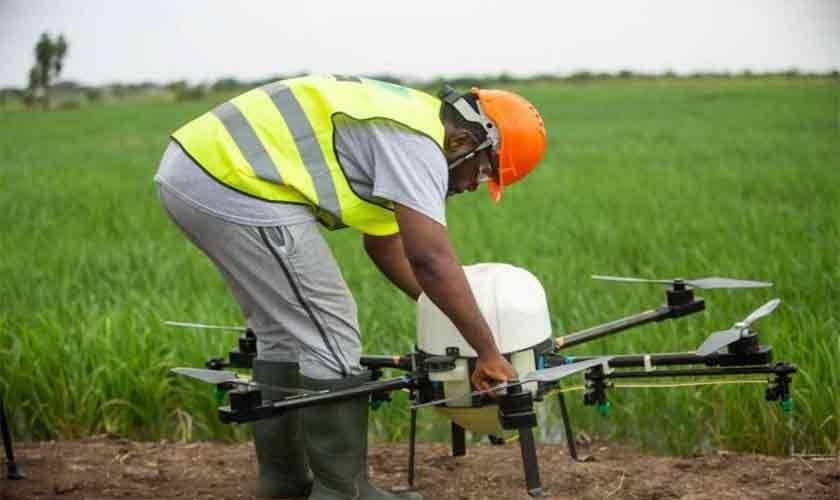Main Points In Hindi (मुख्य बातें – हिंदी में)
-
कृषि की महत्ता: पाकिस्तान की अर्थव्यवस्था कृषि पर निर्भर है, जहां कृषि क्षेत्र जीडीपी में 24% योगदान देता है और लगभग आधी श्रम शक्ति के लिए रोजगार प्रदान करता है। यह क्षेत्र विशेष रूप से निर्यात के लिए भी महत्वपूर्ण है, हालांकि कृषि क्षमता का पूरा दोहन अभी बाकी है।
-
चुनौतियाँ एवं अवसर: पाकिस्तान कृषि के क्षेत्र में जलवायु परिवर्तन, जनसंख्या वृद्धि और बुनियादी ढांचे की बाधाओं जैसी चुनौतियों का सामना कर रहा है। हालाँकि, डिजिटल प्रौद्योगिकियों और नवाचारों का उपयोग करके उत्पादकता बढ़ाने और संसाधनों के बेहतर प्रबंधन की दिशा में अवसर मौजूद हैं।
-
मात्रात्मक वृद्धि की आवश्यकता: औसत कृषि भूमि का आकार पाकिस्तान में लगातार गिर रहा है, जिससे कृषि उत्पादकता में कमी आ रही है। किफायती तकनीक और उचित वित्तीय उत्पादों के विकास से किसानों की आय और उत्पादकता बढ़ाने की आवश्यकता है।
-
महिलाओं का सशक्तिकरण: महिला-केंद्रित वित्तीय उत्पादों और प्रशिक्षण कार्यक्रमों को विकसित करने से लैंगिक असमानताओं को दूर करने में मदद मिल सकती है, जबकि सामूहिक चिरागों (सहकारी समितियों) की स्थापना और सटीक कृषि पद्धतियों को अपनाने का सुझाव दिया गया है।
- सतत विकास: अंतिम लक्ष्य एक अधिक उत्पादक, लचीली और टिकाऊ कृषि प्रणाली बनाना है, जो प्राकृतिक संसाधनों को संरक्षित करते हुए बढ़ती वैश्विक आबादी की खाद्य जरूरतों को पूरा कर सके।
Main Points In English(मुख्य बातें – अंग्रेज़ी में)
Here are the main points from the provided text in English:
-
Agricultural Economy and Challenges: Pakistan is primarily recognized as an agricultural economy but struggles with the stability of its exports. The country has not fully tapped into its agricultural potential, which poses challenges to its aggressive economic development goals.
-
Significance of Agriculture: The agricultural sector is the largest component of Pakistan’s national economy, contributing about 24% to the GDP and providing nearly half of the labor force with employment. Despite its significance, the country is reliant on imports for several agricultural products such as wheat, vegetable oils, and pulses.
-
Land Utilization and Production: Around 47% of Pakistan’s land is used for agriculture, which is above the global average. The country ranks 8th in the world in agricultural production but faces issues with decreasing average farm sizes and increasing reliance on imports.
-
Technological Innovations and Opportunities: The rise of digital technologies offers new opportunities in agricultural finance, potentially connecting farmers directly to markets and providing them with valuable information to enhance productivity. Initiatives like digital platforms and value chain financing can support smallholder farmers by improving access to resources and technology.
- Sustainability and Resilience: Climate change and resource constraints present unprecedented challenges for Pakistani agriculture. A need for innovation, investment in research, and enhanced partnerships is essential to build a more productive and sustainable agricultural system that can meet the food needs of a growing global population while preserving natural resources for future generations.


Complete News In Hindi(पूरी खबर – हिंदी में)
निर्यात में स्थिरता के लिए संघर्ष कर रहा पाकिस्तान आज भी कृषि अर्थव्यवस्था के रूप में पहचाना जाता है। हालाँकि, इसे अभी भी अपनी कृषि क्षमता का पूरी तरह से दोहन करना बाकी है। कृषि क्षेत्र में पर्याप्त वृद्धि के बिना, पाकिस्तान में आक्रामक आर्थिक विकास की महत्वाकांक्षा अवास्तविक है।
कृषि राष्ट्रीय अर्थव्यवस्था का सबसे बड़ा क्षेत्र है। आबादी का एक बड़ा हिस्सा इस सेक्टर पर निर्भर है. यह सकल घरेलू उत्पाद में लगभग 24 प्रतिशत का योगदान देता है और श्रम शक्ति का लगभग आधा हिस्सा है। यह विदेशी मुद्रा आय का सबसे बड़ा स्रोत भी हैमैं.
30.5 मिलियन हेक्टेयर के साथ, लगभग 47 प्रतिशत भूमि कृषि के अंतर्गत है, जो वैश्विक औसत 38 प्रतिशत से अधिक है। पाकिस्तान दुनिया के सबसे बड़े खाद्य उत्पादकों में से एक है। सकल घरेलू उत्पाद क्षेत्र संरचना द्वारा देशों की सूची के अनुसार, यह कृषि उत्पादन में विश्व स्तर पर 8वें स्थान पर है।
गेहूं और गेहूं का आटा, वनस्पति तेल, दालें, चाय और परिष्कृत चीनी का आयात अस्वीकार्य होना चाहिए। कुछ वर्षों में वनस्पति तेल, गेहूं और आटा, कृषि आयात का 80 प्रतिशत तक हिस्सा रहे हैं।
पाकिस्तान के पास लगभग 1,046 किलोमीटर लंबी तटरेखा और शुरुआत के लिए पर्याप्त मत्स्य संसाधन हैं।
विश्व स्तर पर, संयुक्त राज्य अमेरिका, चीन, भारत और रूस लगातार प्रमुख अनाज और सब्जी फसलों के शीर्ष उत्पादकों में शुमार हैं। चीन चावल उत्पादन में अग्रणी है, गेहूं का शीर्ष उत्पादक है, मकई का दूसरा सबसे बड़ा उत्पादक है और प्याज और गोभी के निर्यात पर हावी है। अमेरिका मक्के में पहले, सोयाबीन में दूसरे और गेहूं में चौथे स्थान पर है। बाजरा जैसी अन्य प्रमुख फसलों में भारत और नाइजीरिया उत्पादन में अग्रणी हैं। रूस, जर्मनी और भारत में जौ, राई और दालें महत्वपूर्ण हैं।
अपनी बड़ी आबादी को देखते हुए, चीन और भारत आंतरिक खाद्य सुरक्षा को प्राथमिकता देते हैं। इनका अधिकांश उत्पादन घरेलू स्तर पर उपयोग किया जाता है।
बड़े पैमाने पर उत्पादन और उच्च मूल्य वाले उत्पादन के बीच अंतर पर ध्यान देना महत्वपूर्ण है। नीदरलैंड फूलों के वैश्विक निर्यात का लगभग आधा हिस्सा आपूर्ति करता है। यह टमाटर और मिर्च का भी एक प्रमुख आपूर्तिकर्ता है)। दुनिया को खिलाने वाले मुख्य खाद्य पदार्थ (चावल, मक्का, गेहूं, सेम, दाल और पशु प्रोटीन) ज्यादातर संयुक्त राज्य अमेरिका, जर्मनी, कनाडा, ब्राजील और थाईलैंड से आते हैं।
जलवायु परिवर्तन, जनसंख्या वृद्धि और संसाधन/बुनियादी ढांचे की बाधाओं से अभूतपूर्व चुनौतियों का सामना करते हुए, पाकिस्तान में कृषि एक महत्वपूर्ण मोड़ पर है। कृषि पद्धतियों और खाद्य उत्पादन में सकारात्मक बदलाव लाने के लिए नवाचार आवश्यक है।
पाकिस्तान में औसत कृषि आकार में लगातार गिरावट आई है:
1971 में 5.3 हेक्टेयर
2000 में 3.1 हेक्टेयर
2010 में 2.6 हेक्टेयर
इस बीच, नीदरलैंड में प्रति कृषि योग्य खेत का औसत उपयोग किया जाने वाला कृषि क्षेत्र 2000 में 32.5 हेक्टेयर से बढ़कर 2021 में 41.4 हेक्टेयर हो गया।
डिजिटल प्रौद्योगिकियों का उदय कृषि वित्त में नए अवसर प्रस्तुत करता है। डिजिटल प्लेटफ़ॉर्म किसानों को सीधे बाज़ारों से जोड़ सकते हैं, संभावित रूप से मुनाफ़ा बढ़ा सकते हैं और निर्णय लेने के लिए मूल्यवान जानकारी के साथ उन्हें सशक्त बना सकते हैं।
क्या हमें प्रभावी कृषि आकार बढ़ाने के लिए सहकारी समितियाँ बनानी चाहिए? अन्यथा, क्या हमें सटीक कृषि और अधिक कुशल जल उपयोग की ओर बढ़ना चाहिए?
औसत किसान एक तनावग्रस्त, अधिक काम करने वाला और कम सेवा पाने वाला व्यक्ति है, जिसके पास संसाधनों, प्रौद्योगिकी और वित्तीय सेवाओं तक पहुंच का अभाव है। बढ़ी हुई उत्पादकता के साथ पर्यावरण संरक्षण एक बड़ी चुनौती है जिसके लिए किसानों को विशेषज्ञों द्वारा मार्गदर्शन की आवश्यकता है।
एचबीएल जराई सर्विसेज लिमिटेड की जराई डेरा पहल बेहतरी के लिए प्रक्षेपवक्र को बदलने की कोशिश कर रही है। विचार नि:शुल्क कार्रवाई योग्य कृषि संबंधी सलाह के लिए एक मंच बनाने का है जो गुणवत्तापूर्ण कृषि आदानों के लिए वन-स्टॉप समाधान भी प्रदान कर सकता है, जिसमें पशुधन स्वास्थ्य पर पूरक सलाह के साथ-साथ गुणवत्तापूर्ण पशु चारा, एक मशीनरी केंद्र, एक बैंक कियोस्क और सूचित वित्तीय तक पहुंच शामिल है। तकनीकी या कृषि विशेषज्ञ।
आशा है कि इस तरह की पहल से छोटे किसानों को अपनी कृषि उत्पादकता और आजीविका में उल्लेखनीय सुधार करने में मदद मिलेगी। फसल की पैदावार बढ़ाने और फसल कटाई के बाद होने वाले नुकसान को कम करने के लिए किफायती तकनीक विकसित करने से आय बढ़ सकती है। अनुकूलित वित्तीय उत्पाद किसानों को कुशलतापूर्वक निवेश करने और जोखिमों को अधिक प्रभावी ढंग से प्रबंधित करने में मदद कर सकते हैं।
डिजिटल प्रौद्योगिकियों का उदय कृषि वित्त में नए अवसर प्रस्तुत करता है। डिजिटल प्लेटफ़ॉर्म किसानों को सीधे बाज़ारों से जोड़ सकते हैं, संभावित रूप से मुनाफ़ा बढ़ा सकते हैं और निर्णय लेने के लिए मूल्यवान जानकारी के साथ उन्हें सशक्त बना सकते हैं। महिला-केंद्रित वित्तीय उत्पाद, प्रशिक्षण कार्यक्रम और उपयुक्त कृषि उपकरण विकसित करने से लैंगिक असमानताओं को दूर करने में मदद मिल सकती है।
मूल्य श्रृंखला वित्त, जो अब बैंकों से उपलब्ध है, संपूर्ण कृषि प्रक्रिया पर विचार करता है, संभावित रूप से इस क्षेत्र को ऋण देने में वृद्धि करता है। सूचकांक-आधारित बीमा और रिमोट सेंसिंग जैसे कृषि बीमा नवाचारों का उद्देश्य छोटे किसानों को बेहतर सेवा प्रदान करना है। सटीक कृषि, जैव प्रौद्योगिकी और स्मार्ट सिंचाई प्रणाली जैसी तकनीकी प्रगति उत्पादकता को बढ़ा सकती है।
जलवायु परिवर्तन अनुकूलन और शमन रणनीतियाँ तेजी से महत्वपूर्ण होती जा रही हैं। बढ़े हुए अनुसंधान निवेश, मजबूत साझेदारी और बेहतर शिक्षा के माध्यम से एक सहायक पारिस्थितिकी तंत्र की त्वरित पहुंच और कार्यान्वयन के लिए डेरा की तरह इन सभी को किसानों के करीब लाने की जरूरत है।
अंतिम लक्ष्य एक अधिक उत्पादक, लचीली और टिकाऊ कृषि प्रणाली बनाना है; जो भविष्य की पीढ़ियों के लिए प्राकृतिक संसाधनों को संरक्षित करते हुए बढ़ती वैश्विक आबादी की खाद्य जरूरतों को पूरा कर सकता है।
लेखक एक शिक्षाविद्, संचार विशेषज्ञ और हेरिटेज फाउंडेशन पाकिस्तान के निदेशक हैं। वह @shahaJamshed ट्वीट करती हैं
Complete News In English(पूरी खबर – अंग्रेज़ी में)
Pakistan is still recognized as an agricultural economy, struggling for stability in its exports. However, it has yet to fully exploit its agricultural potential. Without significant growth in the agricultural sector, Pakistan’s ambitions for aggressive economic development are unrealistic.
Agriculture is the largest sector of the national economy, relying on a substantial portion of the population. It contributes about 24 percent to the gross domestic product (GDP) and accounts for nearly half of the workforce. It is also the largest source of foreign exchange earnings.
Approximately 47 percent of land, which amounts to 30.5 million hectares, is devoted to agriculture, exceeding the global average of 38 percent. Pakistan is among the world’s largest food producers, ranking 8th globally in agricultural output according to GDP sector structure.
Imports of wheat, flour, vegetable oil, lentils, tea, and refined sugar should be minimized. In recent years, vegetable oil, wheat, and flour have constituted up to 80 percent of agricultural imports.
Pakistan has a coastline of about 1,046 kilometers and ample fishery resources to start with.
Globally, countries like the United States, China, India, and Russia are consistently among the top producers of staple grains and vegetable crops. China leads in rice production, is the top producer of wheat, the second-largest producer of corn, and dominates the export of onions and cabbage. The United States ranks first in corn, second in soybeans, and fourth in wheat. In terms of other major crops like millet, India and Nigeria are leaders in production, while barley, rye, and lentils are significant in Russia, Germany, and India.
Given their large populations, China and India prioritize internal food security. Most of their production is used domestically.
It is vital to distinguish between large-scale production and high-value production. The Netherlands supplies about half of the global flower export and is also a major supplier of tomatoes and peppers. Key staple foods (rice, corn, wheat, beans, lentils, and animal protein) predominantly originate from the United States, Germany, Canada, Brazil, and Thailand.
With unprecedented challenges from climate change, population growth, and resource/infrastructure constraints, Pakistani agriculture stands at a crucial juncture. Innovation is essential to bring about positive changes in agricultural practices and food production.
There is a continuous decline in the average size of farms in Pakistan:
1971: 5.3 hectares
2000: 3.1 hectares
2010: 2.6 hectares
In contrast, the average farm size in the Netherlands grew from 32.5 hectares in 2000 to 41.4 hectares in 2021.
The rise of digital technologies offers new opportunities in agricultural finance. Digital platforms can connect farmers directly to markets, potentially increasing profits and empowering them with valuable information for decision-making.
Should we form cooperatives to effectively increase agricultural sizes? Or should we move towards precision farming and more efficient water usage?
The average farmer is often overworked, stressed, and underserved, lacking access to resources, technology, and financial services. Balancing increased productivity with environmental protection is a significant challenge, requiring guidance from specialists.
HBL Zarai Services Limited’s Zirai Dera initiative aims to transform trajectories for better outcomes. The idea is to create a platform for free actionable agricultural advice, providing a one-stop solution for quality agricultural inputs, including supplemental advice on livestock health as well as quality animal feed, a machinery center, a banking kiosk, and access to technical or agricultural experts.
Such initiatives are expected to significantly improve the agricultural productivity and livelihoods of small farmers. Developing cost-effective technologies to boost crop yields and reduce post-harvest losses can enhance income. Customized financial products can help farmers invest efficiently and manage risks effectively.
The emergence of digital technologies opens new avenues in agricultural finance. Digital platforms can connect farmers more directly to markets, potentially raising profits and equipping them with essential decision-making information. Developing female-focused financial products, training programs, and suitable agricultural tools can help reduce gender inequalities.
Value chain finance, now available from banks, takes a comprehensive view of the entire agricultural process, potentially increasing lending in this sector. Innovations in agricultural insurance, like index-based insurance and remote sensing, aim to better serve small farmers. Technological advancements such as precision farming, biotechnology, and smart irrigation systems can enhance productivity.
Strategies for adapting to and mitigating climate change are becoming increasingly crucial. There is a need for closer connections to create a supportive ecosystem through increased research investment, strong partnerships, and improved education, as seen in initiatives like Dera.
The ultimate goal is to create a more productive, resilient, and sustainable agricultural system that can meet the food needs of a growing global population while preserving natural resources for future generations.
The author is an academic, communication specialist, and director at the Heritage Foundation of Pakistan. She tweets at @shahaJamshed




